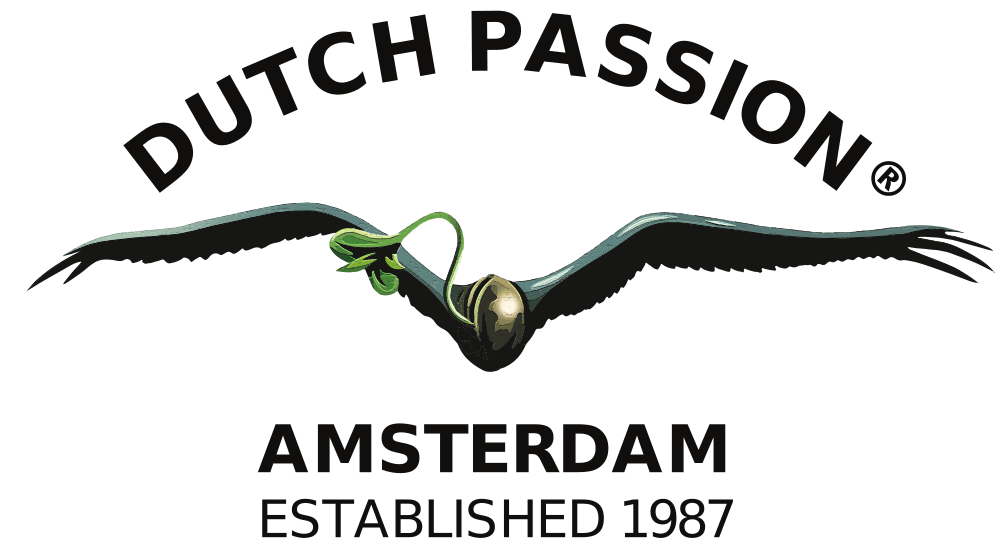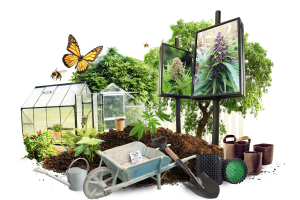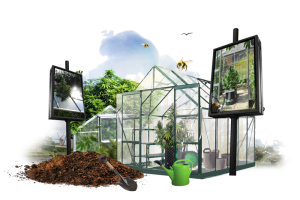When your cannabis leaves start to curl it could be a signal from your plant that there is a potentially serious environmental issue that warrants your attention. The good news is that curling cannabis leaves are often relatively easy to correct, though you may lose some valuable growth until the origin of the problem is rectified.
How to fix cannabis leaves curling up or down
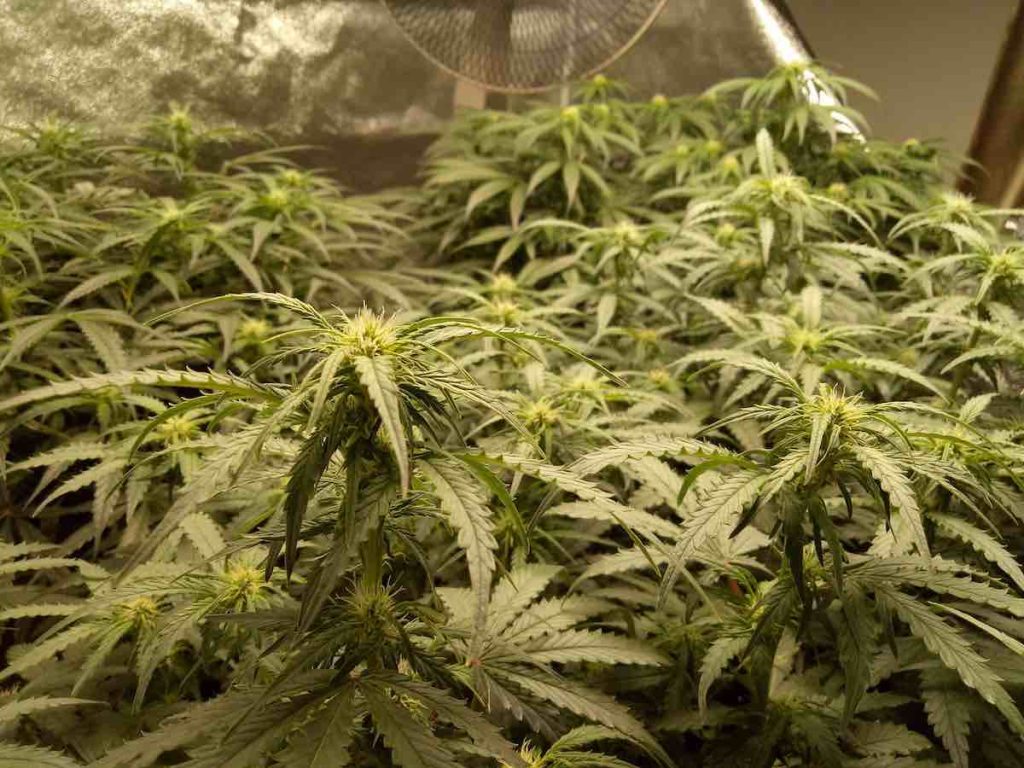
What causes cannabis leaves to curl up or claw?
If your cannabis leaves take on a ‘claw’ like appearance or start to curl it is a sign of environmental problems. The unusual leaf shape and abnormal appearance can often be cured once the cause is addressed. In most cases, the cause of curling/clawed cannabis leaves is usually due to a couple of common errors. Below are the most important factors to consider along with our curing advices.
Cause: Overwatering your cannabis plants

Overwatering of cannabis plants is one of the most common mistakes seen by growers, especially from less experienced or beginner growers. Cannabis root health is key to the overall health/vigour of your plant. Without healthy well oxygenated roots, growth is slowed, and yields/quality compromised.
Overwatering swells the plant cells. This causes the leaves to droop with the leaf fingers perhaps clawing slightly. Cannabis root health and function is also compromised by the poorly aerated conditions at root level.
Not only does this slow/stunt growth, but in the worst cases water-logged soil becomes a breeding ground for dangerous microbes such as Pythium (root rot) and others. At the same time waterlogged conditions prevent beneficial microbes and soil bacteria from performing their normal functions.
Curing overwatering
Less experienced growers should err on the side of under watering rather than water their plants excessively. Seedlings in particular have relatively low water requirements. One tip is to assess the weight of your containers when dry and when freshly watered, only adding more water when the containers feel light enough to warrant it.
If this sounds too risky, then a soil moisture meter could be a worthwhile investment. Simply pop the tip into the soil and record the moisture level. This takes much of the guess work away, though many highly experienced cannabis growers often feel they have the experience to know how much water to add at each stage of plant growth without moisture meters.
Use of highly aerated growing containers such as air pots and fabric/felt grow sacks won’t solve problems caused by the grower who repeatedly over-waters their cannabis plants. But the novel design of these containers means that more oxygen can penetrate the root mass than would be possible in traditional grow containers. Part of the answer to over-watered plants may involve switching to a more aerated grow container.
If your plants are under-watered, the leaves will droop and wilt with a lifeless/limp appearance. This is easy to spot and correct, the plants will soon improve after you provide them with water.
Cause: Overfeeding your cannabis plants
Overfeeding cannabis plants is the other common mistake which contributes to clawed/curling leaves. Excessive mineral content at cannabis root level results in plant biochemistry struggling to remain optimised as the excess minerals reach the leaves. Nitrogen-rich veg nutrients, if given in excess, result in dark leaves and often a pronounced claw-like structure to the leaf.
Curing over fertilisation/overfeeding
Many growers find it difficult to hit and maintain the nutrient sweet spot for their plants from seedling to harvest. Indeed, pro-growers have often spent a great deal of time honing their skills in regard to precise nutrient delivery.
Growers, especially those with less experience, are advised to use weak nutrients and gradually/slowly increase strength as their plants mature. If there is any hint of overfeeding, back off immediately and consider a water flush to dilute mineral concentrations at root level.
Use of EC (electrical conductivity) meters are advised to those that wisely prefer to monitor nutrient preparation with real accuracy. But note that they need to be regularly calibrated and will inevitably fail one day, so you may wish to keep a spare.
But the top Dutch Passion tip to avoid overfeeding/underfeeding cannabis plants is to use slow-release organic nutrients in your grow medium (e.g. soil or coco fibre). Biotabs are especially recommended. These slowly decompose over time, releasing the necessary nutrients in the right amount. They’re fully proven, removing nearly all the complexity of nutrient delivery from your grow.
Cause & cure: Excessive grow room temperatures
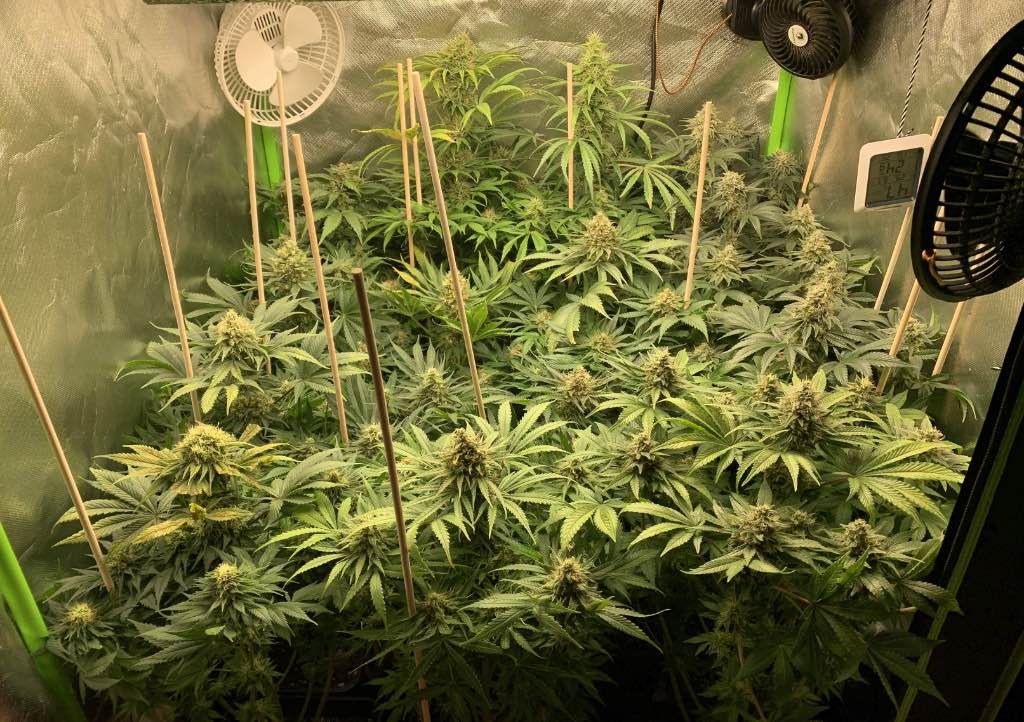
Cannabis leaf edges may wrinkle and become dry/crispy and curled if your temperatures get too high. In hot conditions the leaf cells transpire water faster than it can be supplied, resulting in unusual leaf curling. Reduce your grow room temperature with additional extraction or air-con if available.
You may also want to raise the height of your grow light, which may reduce temperatures at the canopy level (especially when HPS lights are being used).
Some growers reluctantly avoid growing at the hottest times of the year if ambient conditions are simply unacceptable.
Cause & cure: Cold grow room conditions
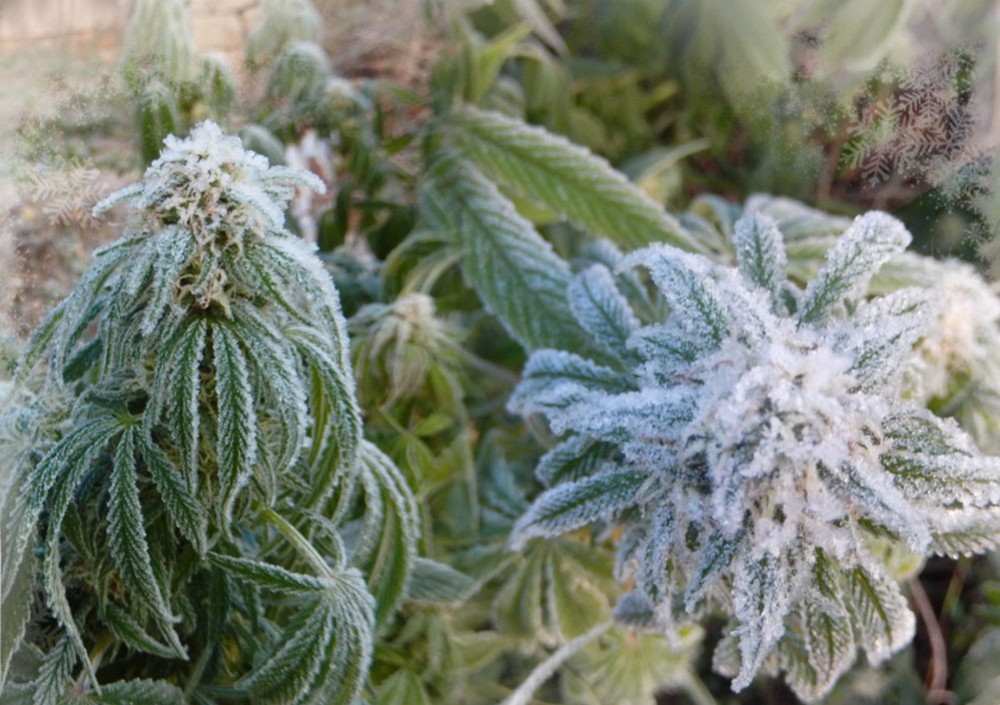
In cold conditions your plant biochemistry and photosynthesis are slowed down significantly. This may produce a plant with leaves which curl slightly downwards.
For outdoor growers, little can be done. But indoor growers simply need to increase their grow room temperature to allow plant growth to revert to normal.
One useful tip for any grower is to buy an inexpensive minimum/maximum thermometer to monitor your grow room temperatures. This shows the temperature range that your plants live in and may help you maintain a more optimised grow environment.
Anyone growing their plants in e.g. a cool cellar may wish to raise their plant pots above the potentially cold stone/concrete surface. Perhaps placing the plant pots on a small stand to prevent the root zone from getting excessively cold which in turn will stunt growth and reduce final yield and potency.
Less experienced indoor cannabis growers seeking some useful general tips may find the Dutch Passion indoor grow guide useful reading as they seek to optimise conditions.
Related:
How to grow cannabis indoors
Cause: Cannabis root issues, what you need to know
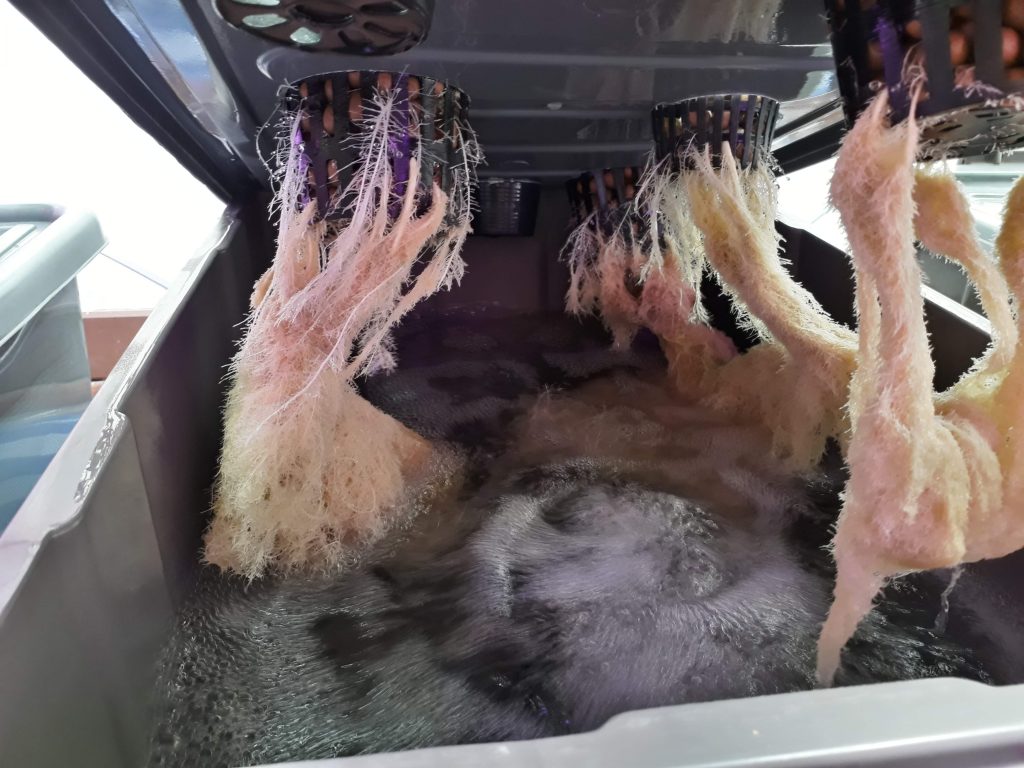
The importance of cannabis root health has already been mentioned but is worth repeating. Without a healthy root mass your cannabis plant won’t be able to supply the water and nutrients required for healthy growth. This often produces visible changes to the cannabis leaves.
Root-bound cannabis plants, where the root ball is tightly knotted and unable to expand, may show curling leaves as the plant struggles to maintain healthy growth. So will plants affected by root rot (Pythium).
Although you can’t as easily make a visual health check on roots like you can on leaves, it’s important to understand the role of root health and its connection to overall plant vigour.
Cause: Heat & light stress
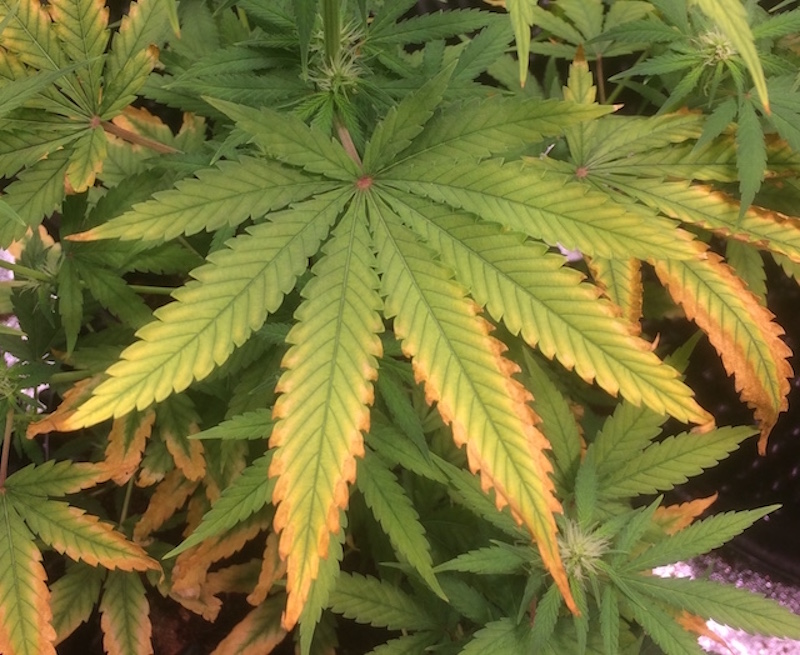
Heat stress can also cause cannabis leaves to curl. Specifically, this is produced by IR (infra-red) wavelengths, which tend to come mostly from HPS/CMH or plasma lights. The leaf edges often curl inwards in an effort to protect themselves from the damaging IR heat.
Upgrading to a quality LED light (with inherently lower IR content) is one solution. But if that’s too expensive, consider reducing light power and/or raise your light further above the canopy.
Light stress, caused by excessively high PPFD levels (light intensity is simply too much), will not only create light green/yellow leaves but often you see the leaf edges curl inwards too as they react to light overload. Simply increase the distance between light and canopy to fix the issue, or reduce the power setting on your light.
The ups and downs of making an accurate diagnosis
The passionate cannabis grower tends to make regular checks on their plants. This really is the best way to monitor cannabis plant growth as well as spot emerging signs of any pests, disease or faltering health. Unusual issues with cannabis leaves are often a sign that something is wrong and needs your attention.
Pests such as mites and fungus gnats can also cause issues. Pest identification and management is a difficult area, if you suspect cannabis pests/disease then our expert guide will help you ID and eliminate them!
Curling cannabis leaves are often easily solved
Curling cannabis leaves are often, but not always, seen by less experienced growers. That may be because less knowledgable growers tend to err more towards over-feeding and over-watering than those that have accrued more grow skills.
Once the grower has benefited from a few successful grows, it becomes easier to assess when the grow container is reaching the point of needing more water. If in doubt, use of an inexpensive soil moisture meter can provide the reassurance required to avoid over watering.
For less experienced growers, a moisture meter can avoid your plants sitting in waterlogged soil and suffering permanently stunted growth.
Keeping your cannabis plants in the nutrient sweet spot may seem equally difficult, but less experienced growers can avoid the difficulties associated with mineral nutrient preparation/delivery by using slow-release organic nutrients such as BioTabs. Using these you may not need to offer anything other than perhaps a light top dressing of general-purpose bloom nutrient during late bloom.
You can see curling cannabis leaves no matter which type of cannabis seeds you are growing, either autoflower seeds or feminised seeds. Remember, curling leaves are not necessarily a sign of a doomed grow, but they may be a sign that your grow room conditions need correcting sooner rather than later.

Basic Guides
Popular varieties
- Auto Blackberry Kush ®
- Auto Blueberry ®
- Auto Brooklyn Sunrise ®
- Auto Cinderella Jack ®
- Auto Colorado Cookies ®
- Auto Daiquiri Lime ®
- Auto Duck ®
- Auto Durban Poison
- Auto Euforia ®
- Auto Frisian Dew
- Auto Glueberry O.G. ®
- Auto Lemon Kix ®
- Auto Mazar ®
- Auto Night Queen ®
- Auto Orange Bud ®
- Auto Think Different
- Auto Ultimate ®
- Auto White Widow ®
- Auto Xtreme ®
- Blue Auto Mazar ®
- Blueberry ®
- Brainstorm
- Bubba Island Kush ®
- C-Vibez ®
- CBD Auto White Widow ®
- CBD Charlotte’s Angel ®
- CBD Compassion ®
- CBD Kush ®
- CBD Skunk Haze ®
- Critical Orange Punch ®
- Desfrán ®
- Durban Poison ®
- Euforia ®
- Freddy’s Best ®
- Frisian Dew ®
- Frisian Duck ®
- Glueberry O.G. ®
- HiFi 4G ®
- Hollands Hope ®
- Jorge’s Diamonds #1 ®
- Kerosene Krash ®
- Master Kush
- Mazar ®
- Meringue ®
- Mokum’s Tulip ®
- Night Queen ®
- Orange Bud ®
- Orange Hill Special ®
- Outlaw Amnesia ®
- Pamir Gold ®
- Passion #1®
- Passion Fruit ®
- Power Plant ®
- Purple #1 ®
- Skunk #11 ®
- StarRyder ®
- Strawberry Cough ®
- Sugar Bomb Punch ®
- The Ultimate ®
- Think Big ®
- Think Fast ®
- White Widow
